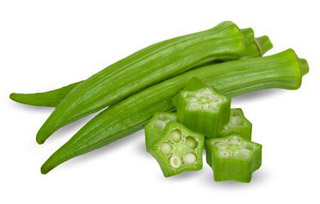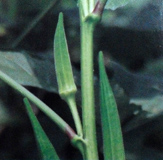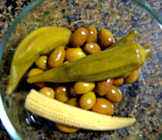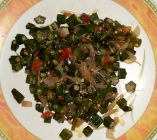Okra nutrition facts and health benefits
Okra nutrition facts and health benefits
Okra nutrition facts
Okra, also known as "lady finger" or "gumbo," is a highly nutritious green edible pod vegetable. Botanically, this perennial flowering plant belongs to the mallow family and named scientifically as Abelmoschus esculentus.
The plant is cultivated throughout the tropical and warm temperate regions around the world for its fibrous fruits or "pods." It grows best in well-drained and manure rich soil. The plant bears numerous dark green colored pods measuring about 5-15 cm in length. It takes about 45-60 days to get ready-to-harvest fruits.
 |  |
| Okra pods. | Okra plant with pods. |
Internally, the pods feature small, round, mucilaginous white colored seeds arranged in vertical rows. The pods are harvested while immature and eaten as a vegetable.
Health benefits of Okra
- The pods are among the very low calorie vegetables. They provide just 30 calories per 100 g besides containing no saturated fats or cholesterol. Nonetheless, they are rich sources of dietary fiber, minerals, and vitamins; often recommended by nutritionists in cholesterol controlling and weight reduction programs.
- The rich fiber and mucilaginous content in okra pods help in smooth peristalsis of digested food particles and relieve constipation condition.
- The pods contain healthy amounts of vitamin A, and flavonoid anti-oxidants such as beta carotenes, xanthin and lutein. It is one of the green vegetables with highest levels of these anti-oxidants. These compounds are known to have antioxidant properties and are essential for vision. Vitamin A is also required for maintaining healthy mucus membranes and skin. Consumption of natural vegetables and fruits rich in flavonoids helps to protect from lung and oral cavity cancers.
- Fresh pods are the good source of folates; provide about 22% of RDA per 100 g. Consumption of foods rich in folates, especially during the pre-conception period helps decrease the incidence of neural tube defects in the offspring.
- The gumbo pods are also an excellent source of anti-oxidant vitamin, vitamin-C, providing about 36% of daily-recommended levels. Research suggests that consumption of foods rich in vitamin-C helps the body develop immunity against infectious agents, reduce episodes of cold and cough and protect the body from harmful free radicals.
- The veggies are rich in B-complex group of vitamins like niacin, vitamin B-6 (pyridoxine), thiamin and pantothenic acid. The pods also contain good amounts of vitamin K. Vitamin K is a co-factor for blood clotting enzymes and is required for strengthening of bones.
- The pods are an also good source of many important minerals such as iron, calcium, manganese and magnesium.
| Principle | Nutrient Value | Percentage of RDA |
|---|---|---|
| Energy | 1.5% | 31 Kcal |
| Carbohydrates | 7.03 g | 5.4% |
| Protein | 2.0 g | 4% |
| Total Fat | 0.1 g | 0.5% |
| Cholesterol | 0 mg | 0% |
| Dietary Fiber | 9% | 3.2 g |
| Vitamins | ||
| Folates | 88 mcg | 22% |
| Niacin | 1.000 mg | 6% |
| Pantothenic acid | 0.245 mg | 5% |
| Pyridoxine | 0.215 mg | 16.5% |
| Riboflavin | 0.060 mg | 4.5% |
| Thiamin | 0.200 mg | 17% |
| Vitamin C | 21.1 mg | 36% |
| Vitamin A | 375 IU | 12.5% |
| Vitamin E | 0.36 mg | 2.5% |
| Vitamin K | 53 mcg | 44% |
| Electrolytes | ||
| Sodium | 8 mg | 0.5% |
| Potassium | 303 mg | 6% |
| Minerals | ||
| Calcium | 81 mg | 8% |
| Copper | 0.094 mg | 10% |
| Iron | 0.80 mg | 10% |
| Magnesium | 57 mg | 14% |
| Manganese | 0.990 mg | 43% |
| Phosphorus | 63 mg | 9% |
| Selenium | 0.7 mcg | 1% |
| Zinc | 0.60 mg | 5.5% |
| Phyto-nutrients | ||
| Carotene-ß | 225 mcg | -- |
| Crypto-xanthin-ß | 0 mcg | -- |
| Lutein-zeaxanthin | 516 mcg | -- |
Selection and storage
Fresh and immature okra pods are readily available in the stores all around the year. The pods feature attractively rich green-color and have neutral flavor. In the store, look for crispy, immature pods and avoid those with over-ripen, sunken appearance, discolored spots, cuts and too soft.
Once at home, place them inside the refrigerator. Eat them while they are fresh to obtain full benefits of vitamins and anti-oxidants.
Preparation and serving methods
In general, some of the hybrid varieties are subject to insecticide/pesticide spray. Therefore, wash the pods thoroughly in the water in order to remove dust, soil and any residual insecticides.
Trim the top stem end using a paring knife. Some prefer trimming tip ends as well. Then, cut/slice the pod as desired.
Here are some serving tips:
 |  |
| Pickled gumbo pods with baby-corn, and beans. Photo courtesy: wharman | Okra pod stir fry with onion, tomato, and green chillies. |
- Okra pods are one of the widely used vegetables in tropical countries. Chopped, or sliced pods are stewed or fried (fritters) under low heat oil in order to soften their mucilaginous content. They then, can be mixed with other vegetables, rice, or meat.
- In Caribbean islands, okra is cooked and eaten as soup, often with fish.
- The pods can be pickled and preserved like in other vegetables.
- Okra leaves may be cooked in a similar manner as the greens of beets or dandelions. The leaves are also eaten raw in salads.

Missed the article, but thanks for posting this great post of information!! Now I can be ready to share it too should anyone ask me about it :)
ReplyDeleteIf you have time please visit http://www.hamiltondietetics.com to get more info about Dietetics and Health Tips as well. Keep up the great work! :D
thank you :)
ReplyDelete